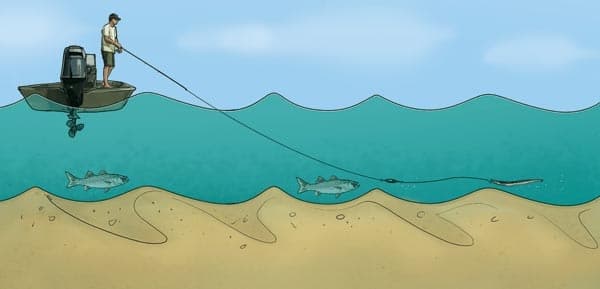Eels are deadly striper baits, both at night and during the day. They can be fished a dozen different ways and are effective almost anywhere these great game fish are found. The challenge is using a delivery system that matches the conditions. With 30 years of chasing stripers behind me, I’ve seen more ways to fish an eel than you can shake a graphite trigger stick at. I’ve culled them down to five methods that can get an eel in front of bass almost anywhere they are found, taking into consideration structure, depth, tides and currents. If you want to catch more bass, add eels to your repertoire.

Joe Mahler / www.markerjockey.com
1. Casting
Casting live eels and swimming them on a slow retrieve is deadly. The tactic can be used from shore or from a boat, in back bays and inlets, and along open beaches, any place bass are working shallows, but it is particularly deadly at night. A friend of mine caught a monster 57-pound bass by walking the sod banks at night in Barnegat Bay, New Jersey, casting a live eel with spinning tackle. I’ve used the technique from my center console for years, casting to beach and inlet jetties and near shore rocks, pretty much anywhere I might throw a plug, but because the eel’s a live bait with an enticing wiggle and scent, it’s usually more effective than slinging plastic or wood.
The rig I use consists of a 7/0 circle hook tied to a 30-inch length of 50-pound fluorocarbon leader with a mini barrel swivel attached to the running line. I rarely add weight, because the eel is being retrieved slowly to keep the line tight. A light- to medium-action spinning outfit will cast the average eel far enough to be quite effective.

Joe Mahler / www.markerjockey.com
2. Shallow Drift
From the Shrewsbury Rocks along the north Jersey coast to the rock fields and cuts between the Elizabeth Islands in Rhode Island’s Narragansett Bay, this technique works great wherever the water is relatively shallow and you’re using a boat to work specific underwater structure. When you locate bass on the depth finder, put the engine in neutral to determine the prevailing drift. Then motor back around the structure, and position the boat so you drift back over the structure with the engine off, trailing your eel close to the bottom, where the bass are holding.
A plugging outfit works best. Keep the reel in free-spool and your thumb on the line. When a bass picks up, let it go for a count of three, put the reel in gear and pick up the slack if the bass hasn’t already done that for you. The circle hook will do the rest. If the water is shallow, 20 feet or less, don’t use any lead; the eel will swim down by itself. If the water is deeper or the drift fast enough to make it hard to keep the eel down, add an egg or rubber-core sinker just above the barrel swivel. Use as little weight as possible. This technique requires you to hunt for those spots where the bass are either feeding or holding, but once you find them, the fishing will be fast and furious.

Joe Mahler / www.markerjockey.com
3. Rumble in the Rips
The mouth of Delaware Bay is home to the Cape May Rips, an extensive series of shallow sand ridges that create standing waves on running tides. Stripers set up feeding stations on the down-tide side of the ridges, where they are quick to jump on a live eel drifted through the rough water. The favored rig is built around a 1- to 4-ounce torpedo-shaped drift sinker with a 3- to 4-foot leader to a hook and eel. The eel is dropped back 50 or more feet behind the drifting boat so that it approaches the rip at a low angle and tracks up and over the shoals, presenting the eel at eye level to bass waiting in ambush.

Joe Mahler / www.markerjockey.com
4. Floaters
This technique is used to fish a live eel over particularly sticky structure by suspending it below a balloon. Eels will swim down into heavy rocks and lodge themselves in the bottom, one of their more annoying habits. A balloon keeps the eel above the structure and in plain sight of feeding stripers. The rig is identical to the one described for shallow drift fishing, with the addition of an egg sinker to keep the eel down. Once the eel is lowered to within a few feet of the bottom, the partially inflated balloon is tied around the line to hold it there.

Joe Mahler / www.markerjockey.com
5. Deep and Fast
The first time I drifted eels in Ambrose Channel, the main shipping channel out of New York Harbor, I couldn’t believe how deep the fish were holding or how fast the tide was running. The rigs we used were tied on three-way swivels with a dropper line to a heavy sinker and a 3-foot leader to the hook. We used conventional tackle stout enough to handle the big sinkers needed to get down 70 feet. As long as we were bouncing on the bottom, the fish ate the eels with abandon. As the tide picked up, we had to up the ante to 16 ounces, but the hits just kept coming. I’ve encountered similar conditions fishing the Race out of Orient Point, New York, and in the ship channels in Delaware Bay, where bass were holding deep and currents were strong. In all cases the results were remarkably consistent: Get the eels down, and you’ll be rewarded.









